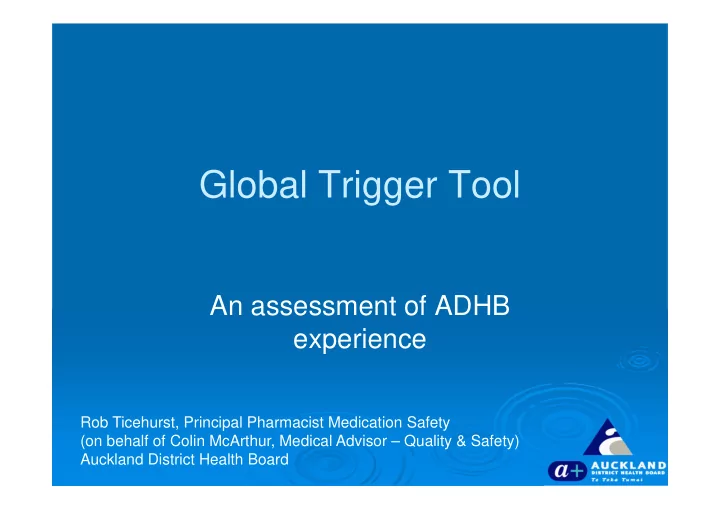

Global Trigger Tool An assessment of ADHB experience Rob Ticehurst, Principal Pharmacist Medication Safety (on behalf of Colin McArthur, Medical Advisor – Quality & Safety) Auckland District Health Board
Setting the scene ADHB: 3400 admissions/month NZ Adverse Events study (Davis et al) Case note review of 6500 patients • all harms: 12.9% • significant harm: ~4% of admissions = ~130/month for ADHB • Preventable significant harms: ~45/month ADHB Reported significant harm events (SAC 1/2) ~6/month GTT IHI suggest AEs in ~30% of admissions • = ~1000/month for ADHB
There’s quite a range! 440 harms (Davis) 1000 harms (IHI) 6 reported (ADHB SAC1/2) Can’t review every patient Sample size is going to be important….
Global Trigger Tool: Methods ADHB ~3400 discharges per month Review 20-40 discharges (>24h admission) per month ~1% ADHB discharges “ unintended physical injury resulting from or contributed to by medical care that requires additional monitoring, treatment or hospitalisation, or results in death ” Acts of commission (not omission) Irrespective of preventability
Global Trigger Tool: Outputs Adverse events Unintended physical injury caused or contributed to by treatment (from patient’s viewpoint) Classification of event type and severity of harm Multiple (separate) events counted Events per 1000 patient-days (typically 90) Events per 100 discharges (typically 40) % of discharges with any events (typically 30%)
Presenting the results – Run chart Simple time plot of number of harms identified from a small sample presented as harms per 1000 pt days.
Same Data
A very brief introduction to control charts4.flv
A closer look… Statistical Process Control Measure current / optimised process mean ± standard deviation (SD) Regular small samples (n) Sample means normally distributed Control limits usually 3 x SD
Adverse event “sampling” An example 1000 discharges Random sample of n=20 Believe our AE rate 20-80% How much variation is there from sample to sample? Is our sample representative of the population?
Example 1 - 30% AE rate 60% 50% 40% 30% 20% 10%
Example 2 - 30% AE rate 60% 50% 40% 30% 20% 10%
Events 100.0 120.0 20.0 40.0 60.0 80.0 0.0 25/07/2011 Adverse Events per 8/08/2011 1000 patient-days 22/08/2011 5/09/2011 19/09/2011 3/10/2011 17/10/2011 31/10/2011 Date 14/11/2011 28/11/2011 12/12/2011 26/12/2011 9/01/2012 23/01/2012 6/02/2012 20/02/2012 5/03/2012
% admissions with adverse events 100% 90% 80% 70% 60% 50% 40% 30% 27% 20% 10% 0% 1 2 3 4 5 6 7 8 9 10 11 12 13 14 15 16 17
Cummulative data accuracy 95% confidence limits 60% 50% 40% 30% 20% 10% 0% 2 4 6 8 10 12 14 16 18 20 22 24 26 28 30 32 34 36 38 40 42 44 46 48 50 52 Week Fortnightly samples of 20, >1000 admissions
Sample size required Trust me on this…. Margin of Sample size error Suspected AE rate = 30% 1% 8281 5% 364 With a sample size of 10 10% 100 we can be 95% confident 20% 29 30% 14 that our actual value is 40% 8 between 0% and 65% (+/- 50% 5 35%) How much uncertainty are you prepared to accept? How much precision do you require?
Conclusion 1 Small sample size Wide confidence limits – our actual AE rate could be anywhere between 0 and 65% Wide limits on control chart Control charts of overall AE rate highly unlikely to be useful to demonstrate the effectiveness of an intervention IHI suggest otherwise….
What if you aggregate the data? ADHB -196 adverse events from 512 admissions over 20 months
Drill down further Medication adverse n Nosocomial infections n events Wound 14 Hypotension/bradycardia 12 Pneumonia 9 Sedation & delirium 10 CLAB 4 Nausea & vomiting 10 Urinary tract 6 Constipation 7 Bacteraemia 7 Chemo complications 8 Other 10 Acute kidney injury 6 Procedure - related n Hypoglycaemia 2 Bleeding 10 Other 10 Ileus 5 Other 27 ADHB - 196 adverse events from 512 admissions over 20 months
Adverse Event Severity E: Temporary harm to the patient and required intervention – 58% F: Temporary harm and required initial or prolonged hospitalization – 38% G: Permanent patient harm – 0.5% H: Intervention to sustain life – 2% I: Patient death – 1.5% ADHB - 196 adverse events from 512 admissions over 20 months
High frequency, low severity 795 admissions to 3 large tertiary USA hospitals Classen et al, Health Affairs 2011; 30(4):581-589
Conclusion 2 Aggregated data can give us an idea of what is happening Identifies areas for further investigation GTT not suitable for demonstrating outcomes of any interventions
Summary Small random samples provides trend over time (but with wide control limits) Large short term variability Accurate population rate can only be estimated over long periods (12 months +) Statistically significant change will take years to demonstrate
Summary Run charts are not useful GTT identifies high frequency “minor” events not detected by other methods Interventions require more targeted/accurate measures (eg CLAB, surgical site infection) Future: Feed into improvement programme priorities? Intermittent larger sampling?
Recommend
More recommend